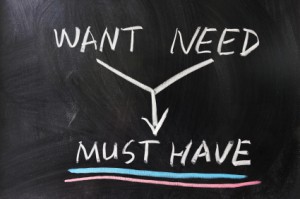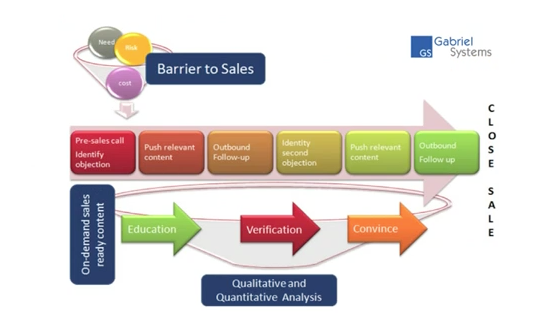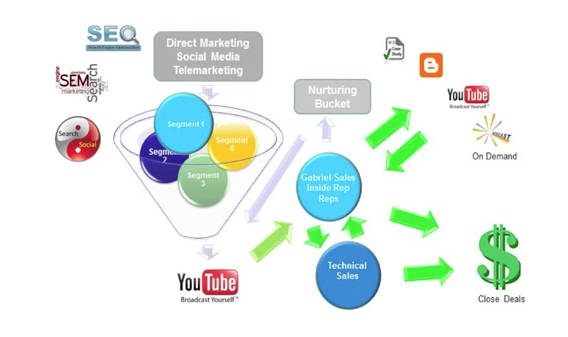by Glen Springer | Apr 30, 2013
 If you take a look around the forums for B2B sales these days, it seems marketers are all buzzing about the promise and potential of webcasts. Marketing Sherpa reported that 30% of B2B marketers are currently using webinars/webcasts as a part of their strategy and have found success with this method.
If you take a look around the forums for B2B sales these days, it seems marketers are all buzzing about the promise and potential of webcasts. Marketing Sherpa reported that 30% of B2B marketers are currently using webinars/webcasts as a part of their strategy and have found success with this method.
So, the question now is not whether or not to use webcasts as a part of your digital content marketing strategy, but how to come up with a sophisticated plan for your webcasts that will get you the most return for your investment.
In order to help you with this endeavor, here are 21 tips regarding using webcasts for B2B selling to generate more leads, improve ROI and ultimately, close more deals.
1. Get the word out.
a. Send email invitations and up to two email reminders for each webcast.
b. Promote the event on social media platforms, with increasing posts the week of the event (Facebook, LinkedIn, Twitter, Google ).
c. Write and post a blog about the event with further details about what the webcast will cover.
d. Require attendees to provide an email address prior to registration (but once they have given their information to you, do not require it again for each subsequent webcast they register for).
e. Encourage participants to “share” that they are attending your event by posting it on their various social media networks.
2. Cultivate an online community.
a. Develop content for your webcasts based on research of your customers’ demographics and biggest business pains.
b. Create one webcast a month (or at least bimonthly) to establish a stable cadence and encourage loyal viewers.
c. Build lasting relationships with prospects using Q&A sessions during and after your webcasts (if your webcast host platform has this feature).
d. Position yourself as a thought-leader within your industry by inviting industry experts to “guest-host” a webcast.
e. Show valuable content in a series or along a planned trajectory so that attendees come back to hear the next part of the “story.”
3. Nurture & Repurpose.
a. If you host your webcasts using a live format, repurpose it afterwards into an On-Demand video so it can be viewed anytime.
b. Host your webcasts on popular hosting sites to optimize for SEO, but also embed them on your own landing pages with your own unique branding.
c. Offer additional pieces of content on webcast landing pages, so your prospects can take themselves further down the buying cycle without any work on your part.
d. Repurpose the main points of your webcast into different types of digital content like blogs, whitepapers, Facebook posts, tweets, etc. that can be used in nurturing campaigns.
4. Measure.
a. Using a marketing automation solution, track data regarding each prospect’s basic demographics and level of engagement.
b. Use the data you collect on prospects to determine their location in their buying cycle and feed them content focused on moving them to the next stage (i.e. if they go to your “About Us” page after viewing a webcast, they are likely earlier in terms of decision making whereas someone who clicks on a “Pricing” page is closer to closing).
c. Give all of the data you collect on your prospects to your sales team (i.e. how many minutes of the webcast they viewed, what webpages they clicked through afterward, etc.), so they can set up conversations based on each prospect’s unique behavior and predetermined needs.
Overall, you want to use webcasts to strengthen your brand story while at the same time providing genuinely valuable content to your prospects. If you take an informed and strategized approach to your webcasts, you can position yourself as an industry leader and simultaneously create a community where people come to solve their business problems. Webcasts allow your prospects to engage with your brand in a one-to-many format but lets them feel like they are having a personalized experience—making you the hero that finally gave them the answer they were looking for.
If you would like to know more about how webcasts help improve your digital content marketing strategy or want to speak to a sales and marketing outsourcing company about content marketing or marketing automation solutions, please contact us.
by gabriel_sales | Apr 19, 2013
 This blog is a quick overview of what defines B2B demand generation and some of the approaches your company can take to succeed.
This blog is a quick overview of what defines B2B demand generation and some of the approaches your company can take to succeed.
What is B2B demand generation?
It’s about giving marketing a sales quota, so let’s start by defining what it’s not. B2B demand generation is not about branding, awareness, positioning or value propositions. These can be important and even critical, but demand generation is not about things that you need a research team or survey to measure.
It’s about giving marketing a sales quota, because buyers now digest an average of 10.7 pieces of content before finalizing their purchasing decisions. So, you need a sales content strategy that supports your inside reps and supports how the buyer buys.
B2B demand generation and lead generation mean different things:
- Demand generation is the marketing and inside sales machine that put deals in and moves them through the pipe.
- Lead generation is the measurable output.
B2B demand generation’s job is to drive and close business. Demand generation sources maketing qualified leads, takes leads from marketing qualified to sales qualified and then engage, nurtures leads not ready to buy (until they are), and supplies the closer with content required to take to proposal and close.
Successful B2B demand generation requires sales content that educates, verifies and finally convinces the customer to transact, along with the right technology to track digital consumption and content repurposed and pushed across media types, all leveraged by a well-trained inside sales team. B2B demand generation is about your reps and marketers having the right conversations and sharing the right information in the right channel at the right time in the customers buying cycle. Demand generation is about taking the content you created to support your reps and repurposing it across digital platforms and social media, so your customers can find you and you sales reps have third-party verification ground cover. Your B2B demand generation engine needs a seamless sales process that integrates sales reps, leverages digital content and improves sales results with the right sales technologies stack.
Here is what a sales driven B2B demand generation process looks like:

First, you put prospects in the pipe using reps, tools, SEO, SEM and social media. You then profile, qualify and engage your prospects. Next, you address one sales objection or buyer stage need at a time. Finally, you push content or nurture until business is closed.
Here is what a mature demand generation ecosystem looks like:

As your buyer move through their buying process (and your sales process) through your initial offers, your inside reps, product specialists and senior talent help the buyer buy seamlessly. You need to do things this way because if you are not making it easy for the buyer, you are not taking competitive advantage of every opportunity you have for sales and marketing ROI efficiency.
To compete, you need to align your teams around how the buyers buy, provide feedback loops to your marketers, create content efficiently, and re-leverage that content every way possible.
How do you sell faster? More effectively? Grow your business? You have two options:
#1 Take up to two years to build your own.
or
#2 Pick the right sales team and sales marketing team to fill your gaps.
Gabriel Sales build machines from scratch or turns around stalled efforts. We specialize in taking existing products into new markets and taking new products into existing markets. We have a diverse B2B sales and marketing team experienced in selling to multiple verticals with solutions for companies selling to both the Fortune 500 and SMB markets that need to sell into sales and marketing, IT, operations and HR and legal budgets. With expertise taking technology, media, SASS data and professional service solutions and products to market.
With Gabriel Sales, your B2B demand generation process can be up and running in as little as two weeks. We can have you set up with a B2B demand generation team and marketing operations deploying a repeatable sales process that is accountable to targets and metrics, selling to your buyer the way they want to buy.
As a B2B demand generation agency, we can help you with:
- Sales strategy and speed to market
- A managed and transparent process
- Smart and authentic sales content creation, production, digital production and distribution
- Staff that executes seamlessly
- Sales tools and all the metrics to maximize ROI
Services range from full-time sales and marketing operations, consulting, staffing, and digital execution, along with a sales and marketing process designed for your specific needs and challenges. To see if Gabriel Sales can help you ramp your sales faster, please contact us.
by Glen Springer | Apr 3, 2013
 In January, Forbes called 2013 the ‘year of the customer’, and when it comes to B2B sales, this statement could not be more true. The customer, not the seller, now controls B2B buying cycles. This means that your marketing strategy and content must be based on a full understanding of who your customer is and structured around meeting the customer on their own terms.
In January, Forbes called 2013 the ‘year of the customer’, and when it comes to B2B sales, this statement could not be more true. The customer, not the seller, now controls B2B buying cycles. This means that your marketing strategy and content must be based on a full understanding of who your customer is and structured around meeting the customer on their own terms.
In order to meet the customer where they’re at, you need to have a clear understanding of where he or she is in the buying cycle for your product or service. Knowing the stage of the buying cycle the prospect is at tells you what marketing content is appropriate to move them to further down the pipe. Giving someone the wrong content at the wrong time will confuse or annoy your prospect, neither of which is an effective sales strategy.
Just as you would not serve crème brulee as a breakfast dish, you should not give a prospect a video of a complex software demo after their first interaction with your company. You need to provide your prospect with a full menu of content options and let their behaviors inform you of what they would like to be served. Using a marketing automation solution, you can watch prospects interact with different “menu options” and gauge if they are in the mood for breakfast or lunch.
Following this metaphor, here are the different stages of the buying cycle for B2B customers along with what type of marketing content is appropriate for each stage.
Stage #1: Breakfast
Prospect expresses interest.
Content types: basic info about value proposition, “welcome” emails, educational blogs, best practices articles, introductory videos
Stage #2: Lunch
Prospect is engaging.
Content types: Invitations to webinars/webcasts, demo videos, segmented content based on specific page views
Stage #3: Dinner
Prospect is ready to make a decision.
Content types: case studies, software demonstrations, service/product options, feature comparisons, white papers, testimonials, pricing
Stage #4: Dessert
Prospect becomes an ongoing customer.
Content types: new product/service info, review/testimonial requests, newsletters, requests for customer data updates
These four stages (or meals) of the buying cycle comprise the majority of the B2B marketing process. However, the problem remains: what if the prospect isn’t hungry?
In cases where the prospect is showing no interest in digesting your content, you need to prove to them how great it tastes. Maybe your prospect is hungry, but you haven’t offered them anything appealing yet. These prospects need to be nurtured with content like surveys to better assess their specific business needs. Prospects that aren’t hungry also need to be given incentives to engage in your content; offering a promotion of some kind may be able to initiate reengagement (e.g. “Today Only: FREE Samples!”).
In summary, we have gone over the various stages of the B2B customer buying cycle and explained what marketing content each stage necessitates. If you have any questions or would like to know more about B2B buying cycles or content marketing, please contact us.
by Glen Springer | Apr 1, 2013
 Marketers in nearly all industries are calling 2013 the ‘Year of the Customer’. This insight reflects the fact that in recent years, the sales cycle for B2B companies has shifted to focus much more on consumer demand. Developments in technologies and the globalization of business have created a world where marketers need to meet their prospects and customers on their own level, when and where the customer choses.
Marketers in nearly all industries are calling 2013 the ‘Year of the Customer’. This insight reflects the fact that in recent years, the sales cycle for B2B companies has shifted to focus much more on consumer demand. Developments in technologies and the globalization of business have created a world where marketers need to meet their prospects and customers on their own level, when and where the customer choses.
Customers now want to be treated like individuals with individual needs and desires. For marketers, this means providing individualized marketing content based on each prospect’s preferences and habits. Without marketing automation, this task can be daunting for B2B companies trying to reach hundreds or even thousands of prospects. When leveraged properly through a well-designed content marketing strategy based on buyer insights, a marketing automation solution can severely decrease the workload required for both B2B marketing and sales teams by reaching hundreds of prospects with a few clicks.
There are nearly endless pieces of the B2B sales and marketing process that can be automated with marketing automation. Here are 3 things that B2B marketers should always automate that will drive revenue while simultaneously decreasing the sales effort required to close:
- Customer/Prospect Data. In terms of new prospects, marketing automation is a great way to start a relationship while exerting very little effort. By creating and automating an email “Welcome Campaign,” you can offer basic information about the business problems you solve and request more information regarding prospects’ needs. You can also use marketing automation to maintain your existing customer relationships by asking them to update their information with any recent changes, which may present you with new opportunities to upsell.
- Reviews & Testimonials. Reviews of your product or service by your existing customers have tremendous value in the new, customer-centric sales cycle. Using marketing automation, you can solicit these reviews and then turn them into marketing content in the future. In addition to requesting reviews or testimonials of your product or service, you can ask reviews of the marketing content your prospects engage in as they move through the nurturing process. This will allow you to give your prospects more incentive to engage in your content (e.g. “This whitepaper was extremely insightful on industry changes and offered amazing tips for generating demand!”–John Smith, CEO) while also giving you feedback on how to improve your own marketing strategies.
- Events. Events are becoming more and more popular in B2B sales and marketing. Digital events like webinars and live demos are a great way to generate new leads and educate and nurture prospects. You can use marketing automation to send out many different types of messages related to an event, depending on a prospect’s behavior. After the initial invitation, you can automate different responses based on if the invitation was opened or if the prospect registered for the event. You can also automate “thank you for attending” emails containing new marketing content to prospects who actually attended your event while sending “sorry we missed you” emails offering recorded versions of the event to no-shows.
Marketing automation has the potential to take all (or at least most) of the guesswork out of the B2B sales cycle. Using marketing automation, you can gather customer insights at the same time you nurture prospects and close deals. Marketing automation puts the information you need to sell at your fingertips, as long as you know what to do with it.
If you would like to know more about how marketing automation helps B2B companies streamline their sales and marketing efforts into one easy-to-manage process, please feel free to contact us.
 If you take a look around the forums for B2B sales these days, it seems marketers are all buzzing about the promise and potential of webcasts. Marketing Sherpa reported that 30% of B2B marketers are currently using webinars/webcasts as a part of their strategy and have found success with this method.
If you take a look around the forums for B2B sales these days, it seems marketers are all buzzing about the promise and potential of webcasts. Marketing Sherpa reported that 30% of B2B marketers are currently using webinars/webcasts as a part of their strategy and have found success with this method.
 This blog is a quick overview of what defines B2B demand generation and some of the approaches your company can take to succeed.
This blog is a quick overview of what defines B2B demand generation and some of the approaches your company can take to succeed.

 In January, Forbes called 2013 the ‘year of the customer’, and when it comes to B2B sales, this statement could not be more true. The customer, not the seller, now controls B2B buying cycles. This means that your marketing strategy and content must be based on a full understanding of who your customer is and structured around meeting the customer on their own terms.
In January, Forbes called 2013 the ‘year of the customer’, and when it comes to B2B sales, this statement could not be more true. The customer, not the seller, now controls B2B buying cycles. This means that your marketing strategy and content must be based on a full understanding of who your customer is and structured around meeting the customer on their own terms. Marketers in nearly all industries are calling 2013 the ‘Year of the Customer’. This insight reflects the fact that in recent years, the sales cycle for B2B companies has shifted to focus much more on consumer demand. Developments in technologies and the globalization of business have created a world where marketers need to meet their prospects and customers on their own level, when and where the customer choses.
Marketers in nearly all industries are calling 2013 the ‘Year of the Customer’. This insight reflects the fact that in recent years, the sales cycle for B2B companies has shifted to focus much more on consumer demand. Developments in technologies and the globalization of business have created a world where marketers need to meet their prospects and customers on their own level, when and where the customer choses.